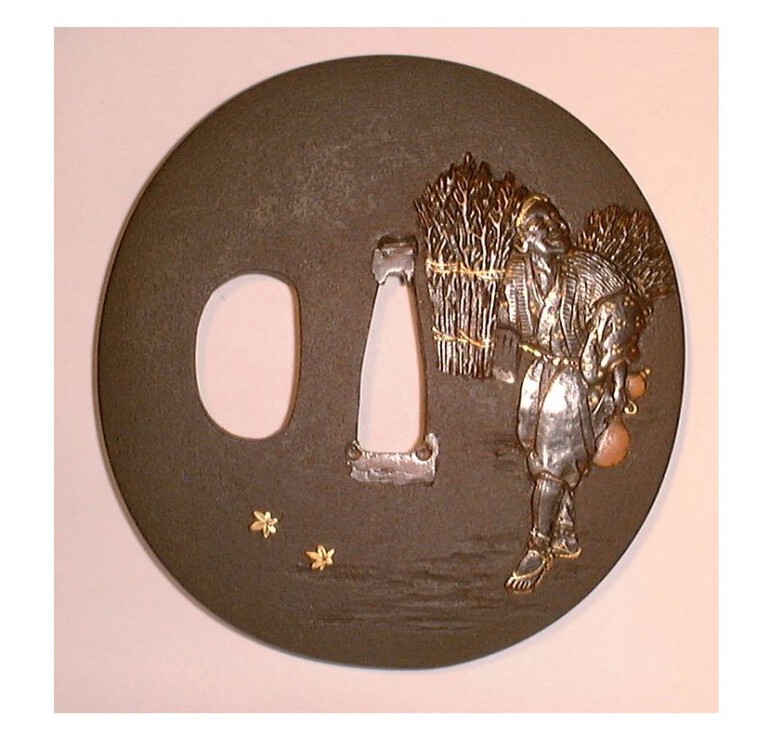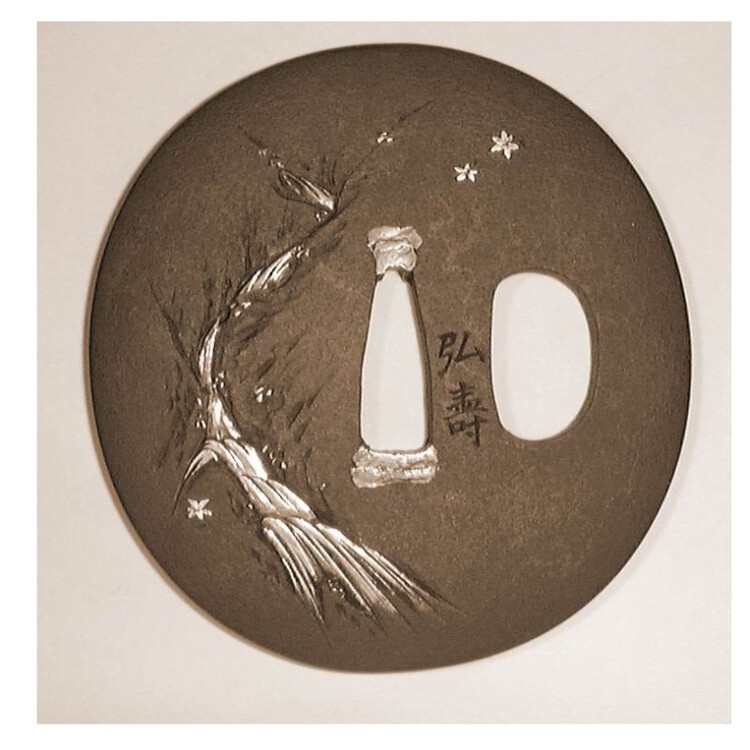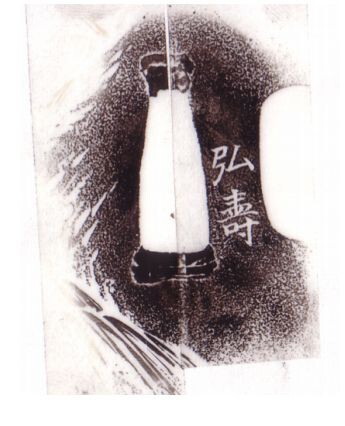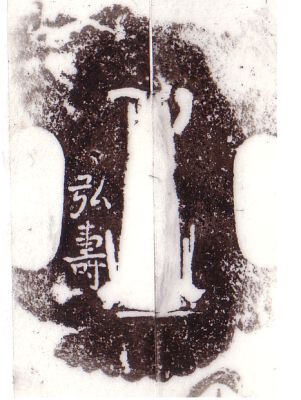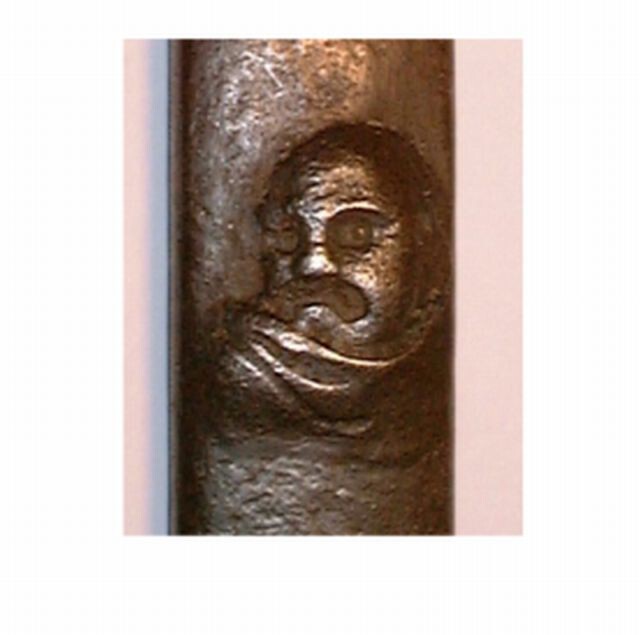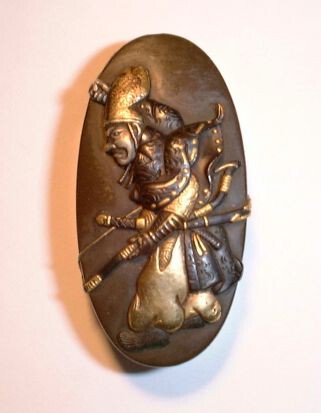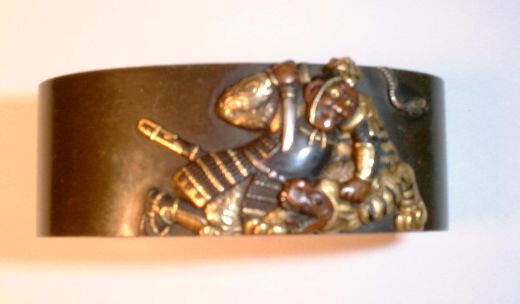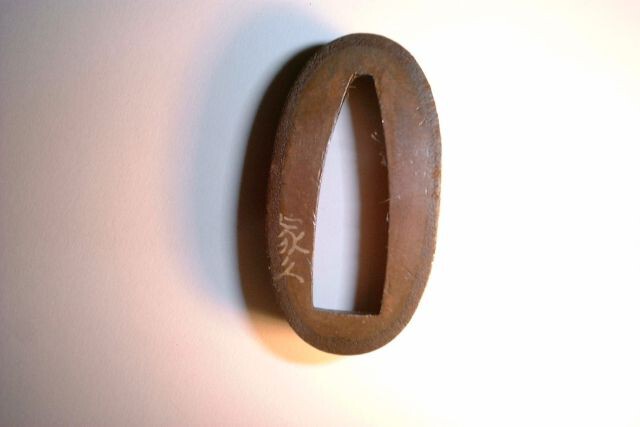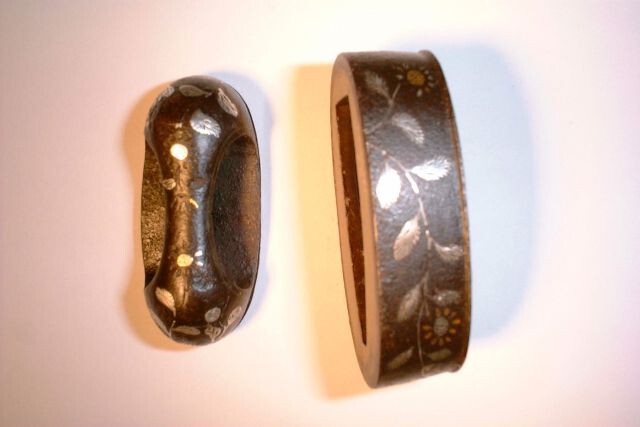-
Posts
815 -
Joined
-
Last visited
-
Days Won
1
Everything posted by docliss
-
Dear Barry As a professed lover of iron work, the attached images of two further iron kodzuka are especially for you. Measuring 9.7 cm – 1.4 cm, the first is of a darkly patinated metal, modelled as a usuniku-bori image of a tachi-style tsuka with five kanji upon it. These read ‘Hachiman Dai Bo Satsu’ (Hachiman Great Buddha Elect), the first being depicted as an ideograph of two doves (hato) back-to-back, with tiny, inlaid silver eyes. These doves, as Hachiman’s attendants, would have been readily identified by any viewer of the piece. The reverse is undecorated and is polished — by wear, I suspect, rather than by intention. It is difficult to envisage a more militaristic kodogu. ? C16 Myōchin work. The second is 9.1 cm – 1.4 cm, and is of a very dark, textured iron. It is divided into five segments, the outside two of which have a beautifully executed, deep transverse grooving. Inside these, and separated from them by gold hira-zōgan diaper inlays, are two segments with delicate, kebori grooving. The centre segment also has a gold hira-zōgan diaper design. The reverse is slightly polished by wear, and is undecorated. The condition of the inlay is remarkably good, considering its apparent age. There is an associated wari-kōgai with this kodzuka but, together, they do not constitute a true futatokoro-mono. ? C17 Kyō-Shoami work. Regards, John L.
- 1 reply
-
- 1
-

-
Dear Richard I am afraid that I have no secret tecnique for the oshigata. I use candle smoke and archive Sellotape, the 'fold' simply being the longitudinal join between two widths of sellotape. Regards, John L.
-
Further to my last message, I have photographed two tsuba in my collection, both inscribed Hirotoshi in the same kanji as on the author’s fuchi –gashira. These are completely different in their tecnique and in the details of their mei. The first of these, labelled Hirotoshi 1, is a very skilful and sophisticated, high relief depiction in shakudo on an iron background, of Shosan bearing a bundle of brushwood. I am sure that this is by the Uchikoshi artist listed by Haynes as H 01416.0. The second of these, labelled Hirotoshi 2, is much cruder work depicting, in iron, a thatched cottage seen through the branches of a tree. The signature differs from that on the former tsuba but may, perhaps, be by the same artist as the maker of the author’s pair of fuchi-gashira. Whether or not this is so, there were certainly two (or more) artists using these kanji in their mei. Regards, John L.
-
The signature shown in Kinko Meikan does not correspond to that on the fuchi-gashira. Neither does that illustrated on D1101, #76, in the Bauer catalogue. Clearly there were more than the single artist of that name, and using those kanji, referred to by Haynes. Regards, John L.
-
I prefer Hirotoshi (see Haynes' H 01416.0). Family name Uchikoshi, and Haynes refers to an iron plate tsuba in the Craig collection by this artist. I hope that this helps. Regards, John L.
-
Dear Ian B It gives me great pleasure to see that you are back in circulation; I look forward enormously to benefitting from your experience and expertise. Regards, John L.
-
Barging rather rudely into Peter's and Ludolf's correspondence regarding the Konkan tsuba, I must add my doubts about it. In my humble opinion, the quality of the work is lacking and both the mei and kao are unconvincing. Without a certificate I would be very reluctant to make a commitment to that one. Regards, John L.
-
Dear Barry Thank you for your comments - I am pleased that you like the kodzuka. I have posted the additional image that you requested. Regards, John L.
-
I should be pleased to read any comments that members may care to make about the attached kodzuka images. The artefact is made of a beautifully textured iron of a dark brown coloration and bears, on its lower third, a low relief engraving of the head of an old man ?Daikoku. There is no soft metal embellishment to this charmingly simple image. The reverse is undecorated and the kodzuka is unsigned. Robinson, in his 'The Arts of the Japanese Sword', suggests that the vertical disposition of the image on kodzuka was introduced by the Yokoya school in the mid-eighteenth century, but surely this piece is earlier than that. Am I correct in my belief that it is Ko-Nara work? Regards, John L.
-
Further to my query regarding Osaki Yoshichika, I have now found both a Yoshichika (H 11467.0) and a Yoshiaki (H 11418.0) in Haynes’ Index, both using an alternative kanji for ‘yoshi’( 美 instead of 善 ). Haynes gives Osaki as the family name of Yoshiaki, and notes that he died ca 1900 – 1920. Yoshichika is stated to have been a student of Tamagawa Yoshihisa. Is it feasible that these two pairs of artists are the same, Yoshichika having changed his original ‘yoshi’ kanji of 善 to 美 after his studentship with Tamagawa Yoshihisa, and Yoshiaki having followed him in this? Regards, John L.
-
Dear Franco, in reply to your query ‘why Mito?’ ... The city of Mito, in Hitachi province, was the home of many skilled metalworkers from the late C17 onwards; that it was the seat of an important branch of the Shōgunal family is likely to be one reason for this. There were numerous family groups working in Mito, the most important of which were the Sekijōken, Kōami, Hitotsuyanagi and Yegawa, together with a number of independent artists. The style of Mito artists was influenced by the teaching of their Yokoya and Nara masters, and there was considerable movement between the many groups. Thus there is a general similarity in their work, although they retain some individuality. Robinson describes their work generally as being ‘fertile in invention, varied in treatment and brilliant in execution’. They worked both in iron and in the soft-metal alloys, and produced both tsuba and the smaller fittings. They tended to favour as subjects the many myths and legends of Japan, many of which are depicted in skilful and delicate iroye. A common impression upon viewing Mito work is o of ‘brightness’. My conviction that the tsuba by Osaki Yoshichika is Mito work is compounded by the fact that Kinkō Meikan states that Osaki Yoshiaki — surely related to the former artist — studied under the Hitotsuyanagi. If you require further evidence of the quality of the work, examine the soldering around the margins of the tenjō I am sure that many of the message board’s more knowledgeable contributors will be able to considerably modify this entry. Regards, John L.
-
-
Does any member have any information regarding OSAKI YOSHICHIKA? I have in my possession a very fine pair of fuchi-gashira signed by this artist. Against a background of polished, dark brown shibuichi is depicted, in a high relief iroye of copper, shakudō, silver and gold, the folk tale of Yorimasa and the Nuye. On the fuchi the hero, with a copper face, is struggling with a tiger with a serpent’s tale. On the kashira Yorimasa holds a torch with copper flames in his right hand and his bow in his left. It is inscribed 大 埼 善 近 with kao, although the second kanji is the alternative form with three final, vertical strokes as shown on p.360 of Koop and Inada. This is outstanding Mito work but, surprisingly, I can find no reference to this artist in any of my reference books. In Haynes’ Index there are several artists of this name but none using these kanji, and Haynes seems to prefer the reading of ‘zen’ to that of ‘yoshi’ for the third kanji. Kinkō Meikan illustrates the signature and kao of Osaki Yoshiaki on p.206a, although there is no mention of this artist in Haynes. Both artists use the same kanji for ‘yoshi’ and the two kao are not dissimilar. I therefore presume that these two artists must be related to one another. Any and all suggestions will be gratefully received, John L.
-
Dear Deron I have come belatedly to this query and am surprised that you have not had any replies to it. They all shout 'Hamano' quite loudly to me. Nice to have contact with you - I trust that you are well? Regards, John L.
-
Dear Milt Thank you - you appear to have answered my question comprehensively. Regards, John L.
-
I have read somewhere that if a pair of fuchi-gashira are so disproportionate in size that the kashira will fit inside the fuchi, this precludes their being a true pair. I have such a pair that appear to belong together, and wonder if their difference is size negates this. Your thoughts on this dilemma will be very welcome. John L.
-
Dear Frank Thank you very much for the kind thought, but the artist that you kindly refer me to was a sword, and not a fittings, man. And still the search goes on! Regards, John L:.
-
Thanks, but again I can find no such artist listed in Haynes' Index. In spite of all your help, I feel that we are not there yet! Regards, John L.
-
Dear Sencho Many thanks so far... I must confess that I'm not completely happy about TOMOTSUNA; there is only one such artist listed in Haynes' Index, and he is described as Bushu. A Bushu pair this certainly isn't, and I feel that the work is too skilled to be by an unklnown maker. John L.
-
So impressed was I by the expertise demonstrated in reply to my last query that I have been prompted to make another. This concerns what appears to be a high quality, C19, Mito fuchi-gashira the mei of which I have been unable to identify. On a chocolate-brown, shibuichi background, carved overall with a low relief wave pattern are depicted, in a high relief iroye of shakudō, shibuichi, silver, copper and several shades of gold, two scenes from the life of Yoshitsune. On the kashira, two warriors are struggling in a boat — possibly Yoshitsune struggling with the ghost of Tominori. On the fuchi, two warriors on horseback are fighting in the water at the battle of Yashima, Yoshitsune reaching into the water for his bow. I find the mei difficult to read. A three-kanji ‘art name’ ending in SAI is followed by TOMO ? SAKU. Thank you for your help, John L.
-
Thank you both very much for your help.. It looks as though Kitamura Iehisa I (or possibly II) is the probable answer here. And Kaga rather than Higo work. Regards, John L.
-
Dear Stephen Thanks again - the possibility of it being an Okamoto Naoshige pair is very exciting, but didn't he use a different kanji for his 'yuki'? John L.
-
Dear Stephen Thank you for your prompt and knowedgeable reply. I still can't find any reference to such an artist - do you know of one? Regards, John L.
-
Dear colleagues Can anybody please help me with the identification of this fuchi-gashira? It is of a darkly patinated iron and both pieces are decorated with hon-zōgan chrysanthemums. The stems and leaves, the latter with kebori detail, are silver. The blooms have alternating gold or silver centres and petals. Both have small, raised rims, the fuchi being tsuboguchi-gata (jar mouth shape) and the kashira natsume-gata. I wonder if they are early Higo work. The mei, which I find very difficult to read, is silver hira-zōgan. Does this read NAGAHISA — I can find no trace of such an artist. With many thanks, John L.
-
The black discoloration of any silver object is, indeed, due to the conversion of the superficial layers of the silver to silver sulphide. That this occurs is due to the presence of atmospheric sulphur, and this was not present in Japan until after its industrialisation. Students more knowledgeable than I will surely able to give us a date for this, but presumably we are talking of the C18. Before this time, any silver fittings would have remained bright - but not shiny - and this is the condition to be sought after today.This is best achieved by an occassional, gentle rubbing with a soft, dry cloth, and never with the use of any metal polish. Regards, John L.







